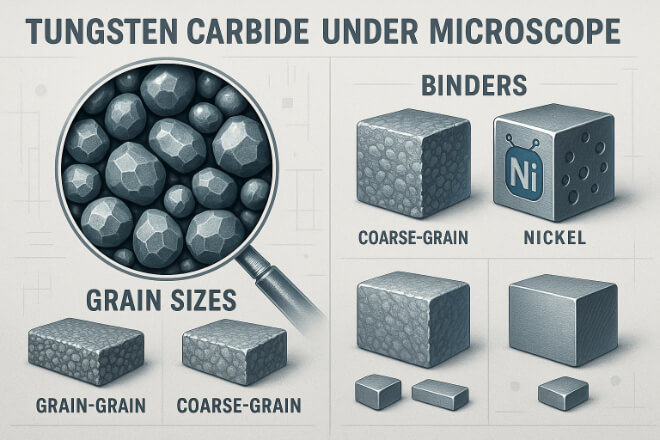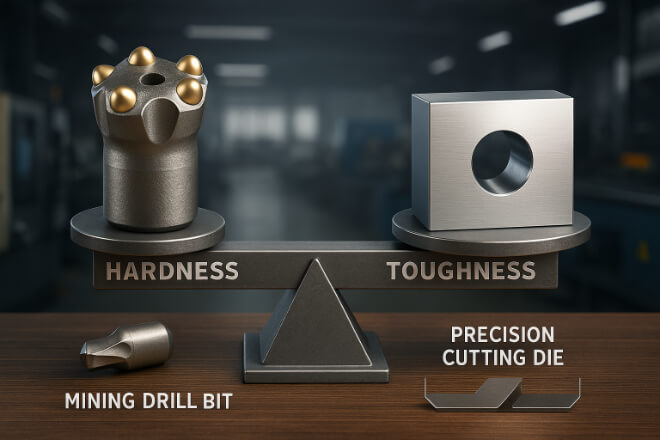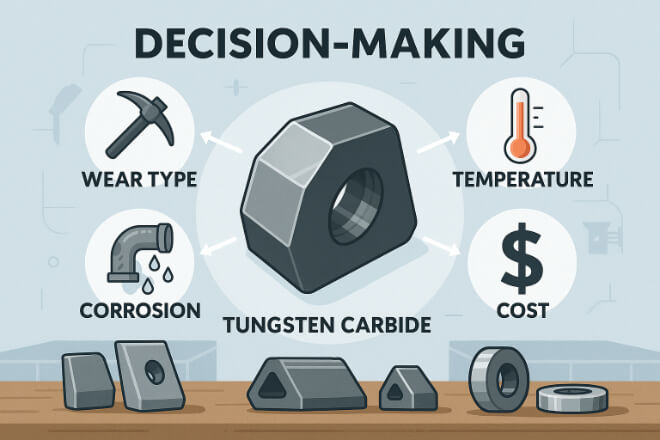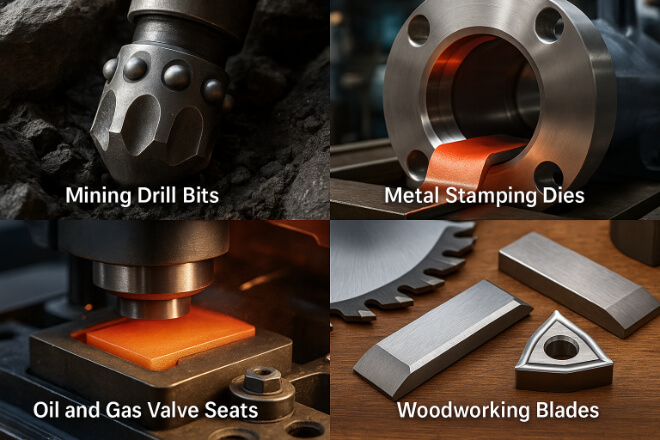Piezas de desgaste de carburo de tungsteno Se utilizan en industrias donde las herramientas se someten a un alto desgaste, calor o impacto. Sin embargo, no todos los carburos de tungsteno son iguales.
Se fabrican diferentes grados para adaptarse a distintas condiciones de trabajo. Elegir el grado incorrecto puede provocar fallos prematuros, mayores costes y tiempo de inactividad. Elegir el grado correcto garantiza la máxima vida útil y rendimiento de la herramienta.
En esta guía, explicamos qué significan las calificaciones, en qué se diferencian y cómo seleccionar la adecuada para su aplicación.
El objetivo es hacer que este proceso sea sencillo y claro, especialmente para los que toman decisiones en el sector manufacturero. minería, petróleo y gas, conformación de metales y otras industrias pesadas.
Comprensión de los grados de carburo de tungsteno

Un grado de carburo de tungsteno es una mezcla de dos cosas principales:
Tamaño del grano de las partículas de carburo
Tipo y porcentaje de aglutinante (generalmente cobalto o níquel)
Diferentes mezclas cambian el dureza, tenacidad, y resistencia al desgaste de la pieza.
El equilibrio entre dureza y tenacidad

Dureza significa resistencia al desgaste, mientras que tenacidad significa resistencia a la rotura o al astillamiento.
Más alto dureza → Mejor resistencia al desgaste, pero menor resistencia al impacto.
Más alto tenacidad → Mejor resistencia al impacto, pero ligeramente menor resistencia al desgaste.
Es por esto que una broca de minería y una matriz de corte de precisión utilizan calidades muy diferentes.
Grados comunes de carburo de tungsteno y sus usos
| Tipo de grado | Propiedades principales | Mejor para |
|---|---|---|
| carburo de grano fino | Alta dureza, excelente resistencia al desgaste. | Herramientas de corte de precisión, matrices, boquillas resistentes al desgaste. |
| carburo de grano grueso | Mayor tenacidad y resistencia al impacto. | Herramientas de minería, brocas de perforación, piezas de desgaste de alta resistencia |
| Carburo submicrónico | Dureza extrema, acabado suave. | Herramientas médicas, mecanizado fino, piezas de precisión. |
| Carburo unido con níquel | Resistencia a la corrosión | Válvulas para petróleo y gas, bombas químicas, aplicaciones marinas |
Factores a considerar al elegir una calificación

A la hora de seleccionar un grado de carburo de tungsteno, los responsables de la toma de decisiones deben tener en cuenta lo siguiente:
Tipo de desgaste: ¿Es desgaste abrasivo, desgaste por impacto o una combinación?
Temperatura de funcionamiento: algunos aglutinantes funcionan mejor a altas temperaturas.
Riesgo de corrosión: si la pieza está en un entorno químico o húmedo, los grados unidos con níquel ayudan.
Costo vs. Rendimiento: un grado superior puede costar más, pero puede durar mucho más.
Ejemplos de la industria

Minería:Carburo de grano grueso para resistencia al impacto en perforación y trituración.
Conformado de metales: carburo de grano fino para matrices y punzones para soportar la abrasión.
Petróleo y gas:Carburo unido con níquel para asientos de válvulas expuestos a fluidos corrosivos.
Carpintería:Carburo de grano medio para un equilibrio entre agudeza y resistencia.
Consejos para quienes toman decisiones

Trabaje con un proveedor que pueda probar muestras para su trabajo específico.
Realice un seguimiento de los patrones de desgaste en las herramientas existentes para comprender qué está fallando primero.
Evite sobreespecificar: un grado más caro puede no siempre mejorar el rendimiento.
Conclusión
Elegir el grado correcto de carburo de tungsteno es un equilibrio entre dureza, tenacidad y necesidades ambientales.
Al comprender el funcionamiento de las calidades, quienes toman las decisiones pueden prolongar la vida útil de las herramientas, reducir el tiempo de inactividad y mejorar la eficiencia. La elección correcta ahorra dinero y aumenta la fiabilidad a largo plazo.
Si desea conocer más detalles sobre alguna empresa, no dude en contactarnos. Contáctanos.
